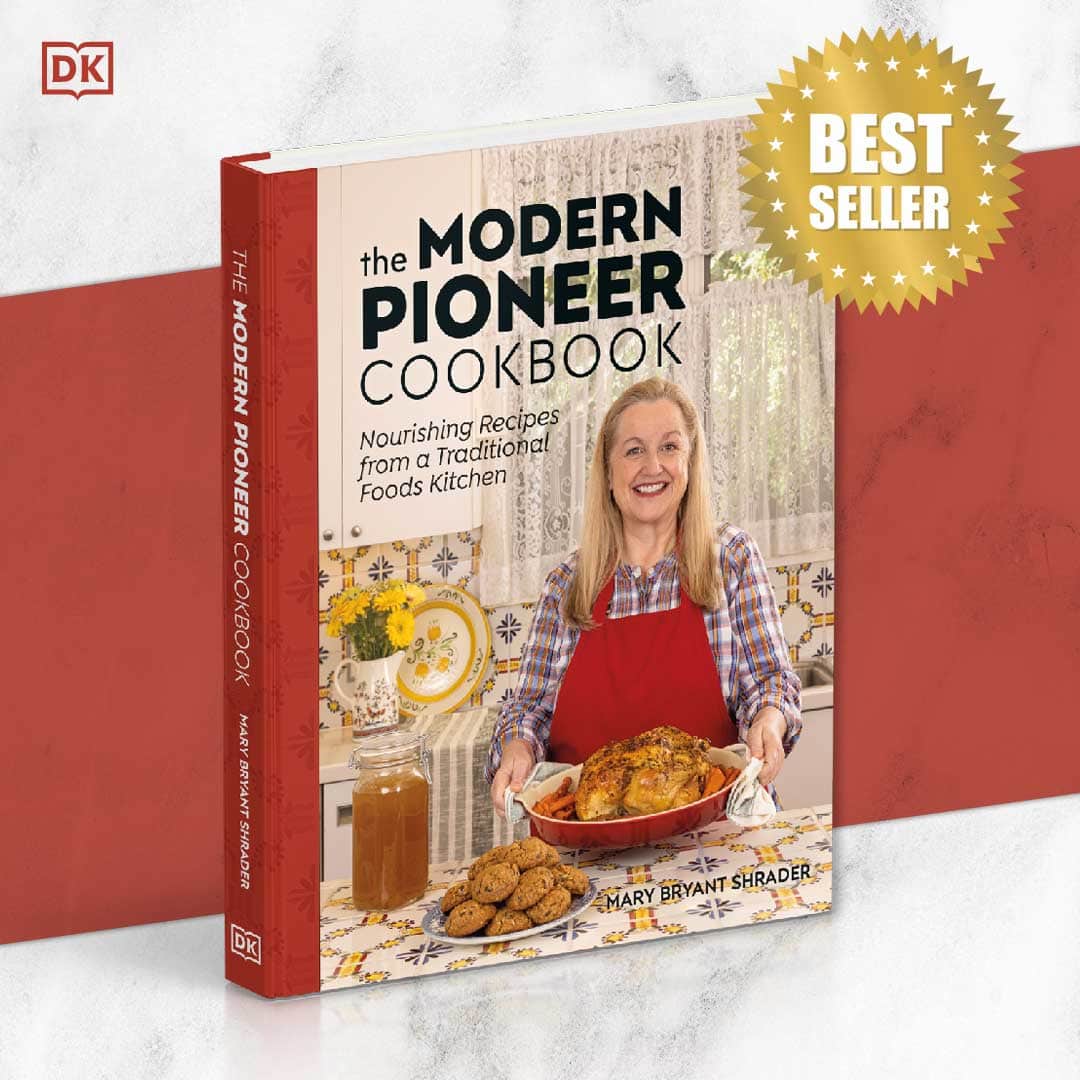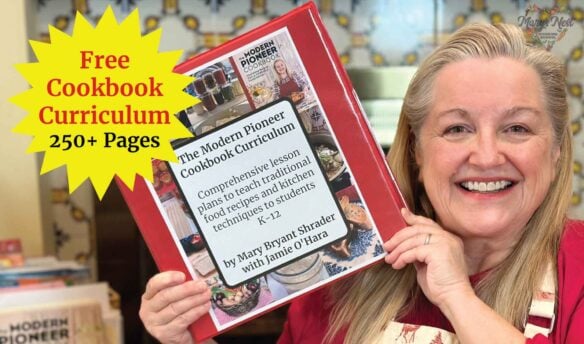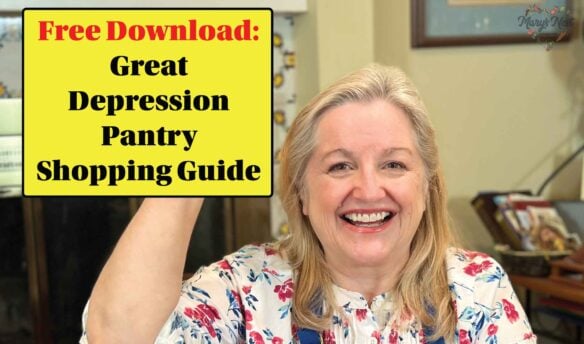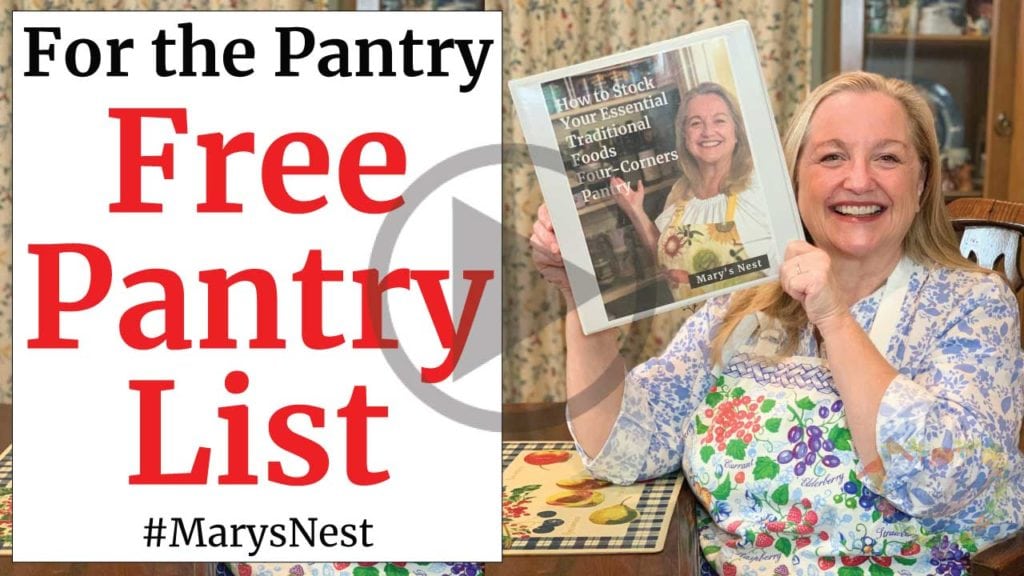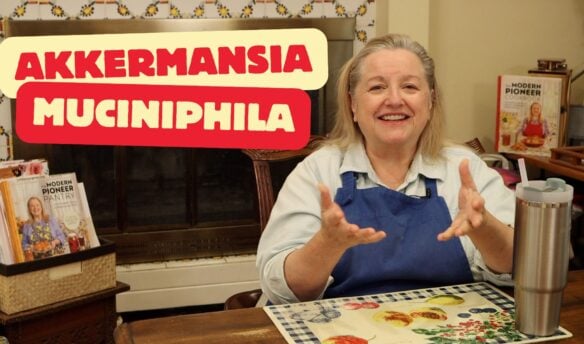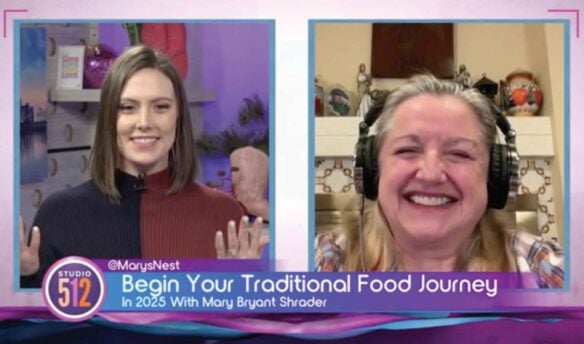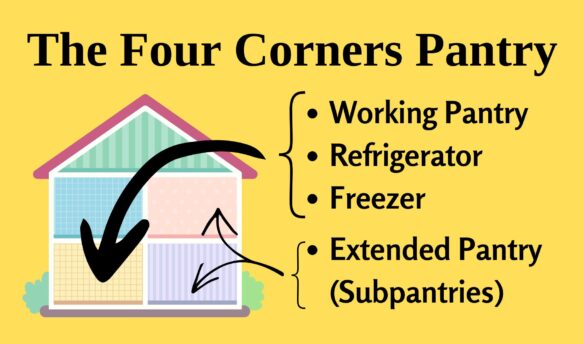I’ve discussed the Four Corners Pantry in previous videos, but this is the first time I’ve dedicated a single video to exploring it and its subpantries. After you watch this video, you’ll understand the Four Corners Pantry and be able to prep like a pro.

Affiliates note: As an Amazon Associate I earn from qualifying purchases. My content may contain affiliate links to products and services. If you click through and make a purchase, I’ll receive a small commission. It does not affect the price you pay.
Table of Contents
- What is the Four Corners Pantry?
- Working Pantry
- Refrigerator
- Freezer
- Extended Pantry Subpantries
- Backup Pantry
- The Emergency Pantry
- Survival Pantry
- Healing Pantry
- Where Should I Locate the Four Corners Pantry in My Home?
- Filling Your Four Corners Pantry with Traditional Foods
- The Modern Pioneer Cookbook
- FREE CHECKLISTS You Need Now!
- Download Your Free 36-Page Pantry List
- Survival Garden Seeds
- Join the Traditional Foods Kitchen Academy
- Kitchen Academy Videos
- Shop for items used in this blog post or video
What is the Four Corners Pantry?
The Four Corners Pantry consists of your:
- Working Pantry – Usually located in your kitchen, this pantry is where you store the non-perishable foods you access on a daily basis.
- Refrigerator – Also typically located in your kitchen, this pantry is where store the perishable foods you need kept cold.
- Freezer – Located with your refrigerator or as a standalone unit, this pantry is where you store the perishable foods you need kept frozen.
- Extended Pantry (also known as the Prepper Pantry) – As you’ll discover, this pantry is more than just a place to store the non-perishable foods you use to restock your Working Pantry.

Working Pantry
The Working Pantry is a cabinet or closet in your kitchen where you store the non-perishable foods you use daily.
- Tour My Working Pantry and Pantry Organization Secrets
- Behind the Scenes: Organizing My Working Pantry (Traditional Foods Kitchen Academy Vodcast)
Refrigerator
The refrigerator is where you store your perishable foods that need to be kept cold. Typically located in your kitchen, so it’s handy to access (like your Working Pantry), your refrigerator will store fresh foods, such as vegetables, purchased from your grocery store and homemade foods, like cultured dairy products.

You’ll also want to store ferments, like sauerkraut, in your refrigerator. The cold will help to slow the fermentation process, give the fermentation ingredients time to combine, and extend the shelf-life of your ferment so you can enjoy it longer. The sweet spot for your ferments is the top shelf or refrigerator door since those areas are a little warmer than the deeper recesses of your fridge.
Here are a few recipes you can make and store in your refrigerator:
Freezer
The freezer is where you store your perishable foods that need to be frozen. It is typically attached to your refrigerator and located in your kitchen, or it can be a standalone unit placed in your laundry room or garage.
You should place foods in your freezer that you want frozen to extend their shelf life. For example, if you return from the farmers market with a bounty of meats and bones, you should store them in your freezer until you’re ready to cook them or use the bones to make bone broth.

If you have a large family and like to make meals ahead of time that you can freeze and then pop into the oven when you’re ready to warm up dinner, the freezer is also an excellent place to hold all your make-ahead frozen meals. Just be sure to package your items correctly before placing them in your freezer.
Here are some meals you can make beforehand and place in your freezer for later rewarming:
- Homemade Stuffed Shells with 1-Minute Tomato Sauce
- How to Make Collagen Rich Bone Broth for Under $2 (uses the chicken bones and chicken feet in your freezer
- How to Make Meal Prep Fast with the Meal-in-a-Bag System (also talks about containers you can use in your freezer)
- How to Make Turmeric Tea Ice Cubes – an Anti-Inflammatory Drink

Extended Pantry Subpantries
The Extended Pantry contains the following subpantries:
- Backup Pantry – Where you store the non-perishable foods you use to restock your Working Pantry.
- Emergency Pantry – Where you store a two-week supply of non-perishable food that you can prepare without electricity or clean water.
- Survival Pantry – Where you store foods that can last “forever.” You’ll be surprised how many foods are considered forever foods.
- Healing Pantry – Where you store the ingredients you’ll use to make natural home remedies.
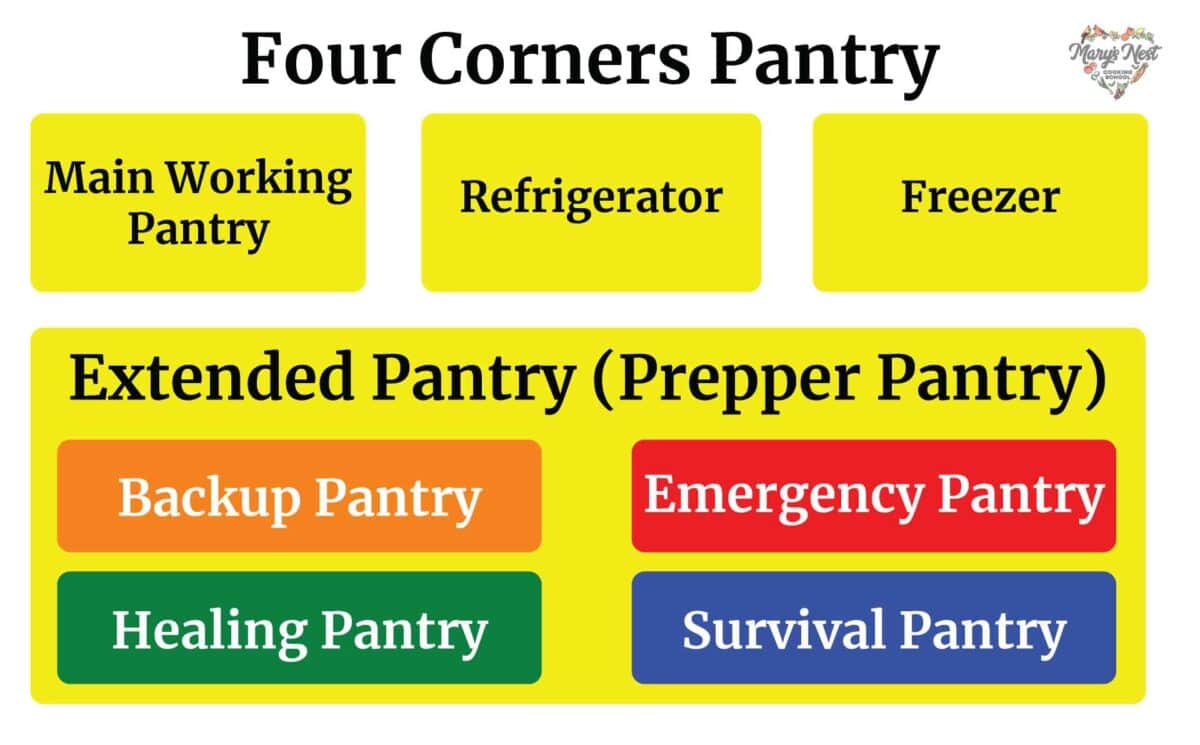
Your Extended Pantry is also known as your Prepper Pantry, and here are a few videos to help you get started building yours:
- What is a Prepper Pantry? And why we all need one!
- How to Stock Your Prepper Pantry with Real Food
- How to Stock Your Prepper Pantry for $5 a Week with a Prepper Pantry Grocery List
And here are videos to help you learn about how to store food in your Prepper Pantry:
- Prepper Pantry Food Storage 101 – Where Do I Begin?
- What is the Difference Between Oxygen Absorbers and Silica Gel Packs?
- The Best Food Storage Supplies for Your Prepper Pantry
Backup Pantry
The Backup Pantry is part of your Extended Pantry, where you store non-perishable foods that you don’t need daily or don’t have room for in your Working Pantry. When your Working Pantry runs low, you can refill it with items from your Extended Pantry.
A Backup Pantry is convenient since it:
- Enables you to store extra food.
- Provides you with additional food if you can’t get to the grocery store
- Protects against supply chain shortages
- Allows you to stock up on items when available or on sale
We don’t have to go back to the events of 2020 to know that we might not be able to get to the grocery store or that items we rely upon may not be available because of supply chain disruptions. A natural disaster with long-term effects, such as a hurricane or the ice storm that shut down Texas for days, is another reason we want to keep our Backup Pantry well stocked.
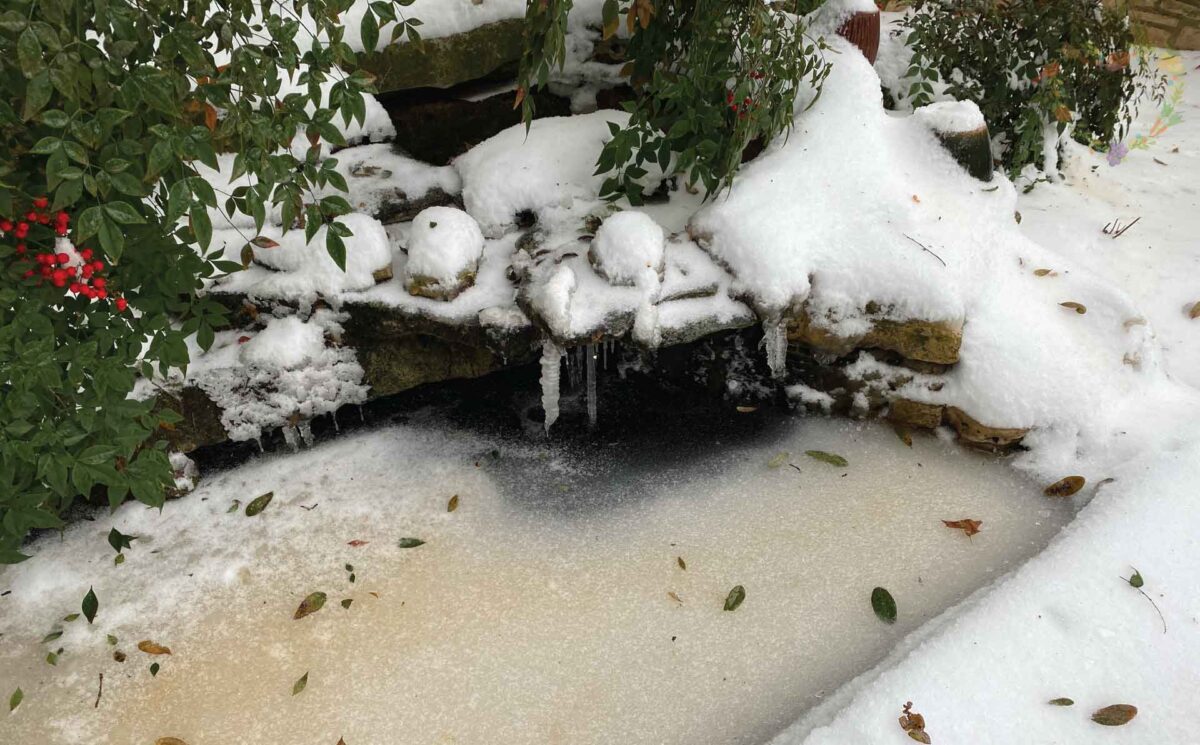
And in this era of inflation, a can of chicken today might be more expensive tomorrow—significantly so. With your Backup Pantry, you can stock up on the items you need when they’re on sale or before upcoming price increases.
Here are a few videos to give you strategies to fight food inflation and rising grocery prices:
- Why You Need to Create Multiple Streams of Food
- How to Fight Rising Grocery Prices with Free Checklist
The Emergency Pantry
The Emergency Pantry is part of your Extended Pantry, where you store two weeks of non-perishable foods. You can prepare these foods if you’re at home, can’t travel, and don’t have electricity or clean running water.
You’ll rely on the food and equipment in your Emergency Pantry to help you and your family through natural disasters or major disruptions when you can’t leave your house. Note that you’re storing both non-perishable food and equipment to help you cook and use your food, such as a manual can opener.

Watch my How to Build a 2-Week Emergency Food Supply video, where I talk in detail about how to create your Emergency Pantry. And be sure to download my free Two Week Emergency Food Supply Shopping List and Meal Plan to help you shop for your non-perishable food. You can store the printed Meal Plan with your emergency food so you don’t have to worry about what to prepare when you may be under stress.
Two weeks of emergency food will typically help you through most emergencies. Power, water, and other help should be back online and available before the end of the two weeks so you return to the grocery store and make regular meals.
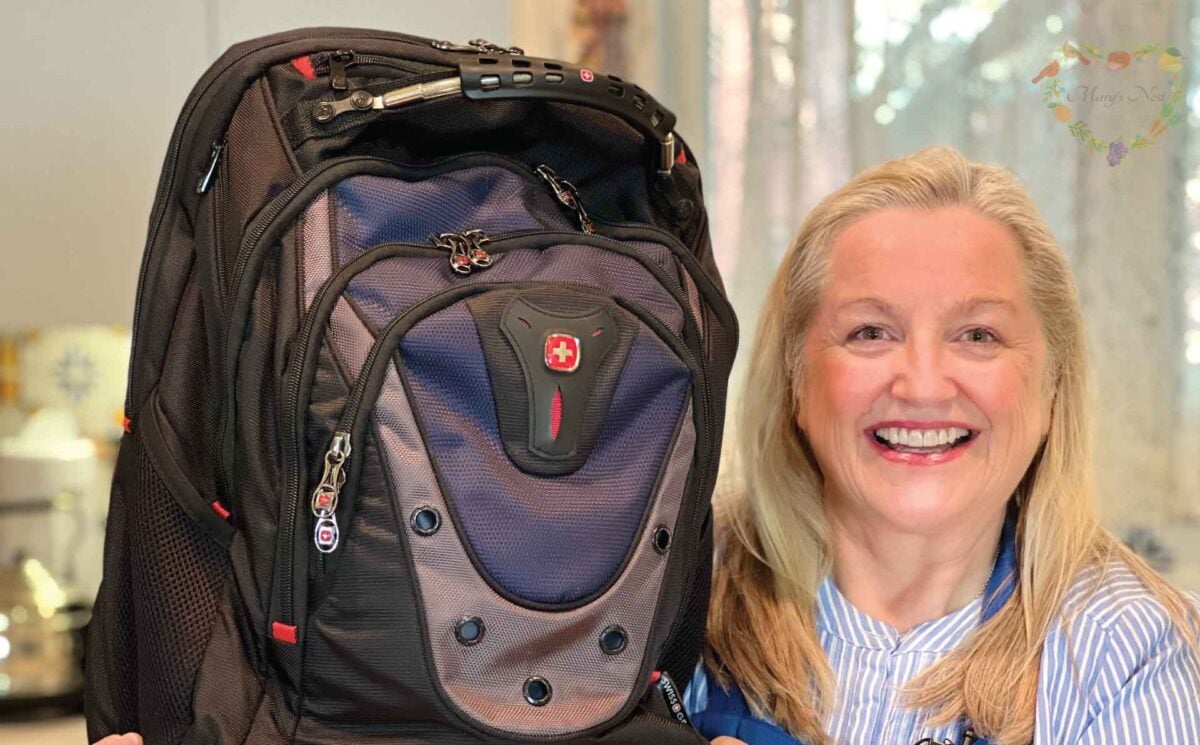
Emergency Backpack
But what happens if you have to leave your home in an emergency? You can prepare for those unexpected times when you have to bug out by packing an emergency backpack ahead of time. I’ll show you how in my How to Pack Your Emergency Backpack Food Kit with Real Food video.
- Build a Basic Disaster Supplies Kit (Get more resources for your emergency kit in addition to the real foods that you’ve prepared for your Emergency Pantry and Emergency Backpack.)
Survival Pantry
The Survival Pantry is part of your Extended Pantry, where you store non-perishable foods that have a very long shelf life. As I show you in the following videos, you don’t need to buy fancy dehydrated or expensive freeze-dried foods to stock your Survival Pantry:
- 27 Best Survival Foods to Stock NOW in Your Prepper Pantry
- 10 Best Forever Foods for Your Survival Pantry
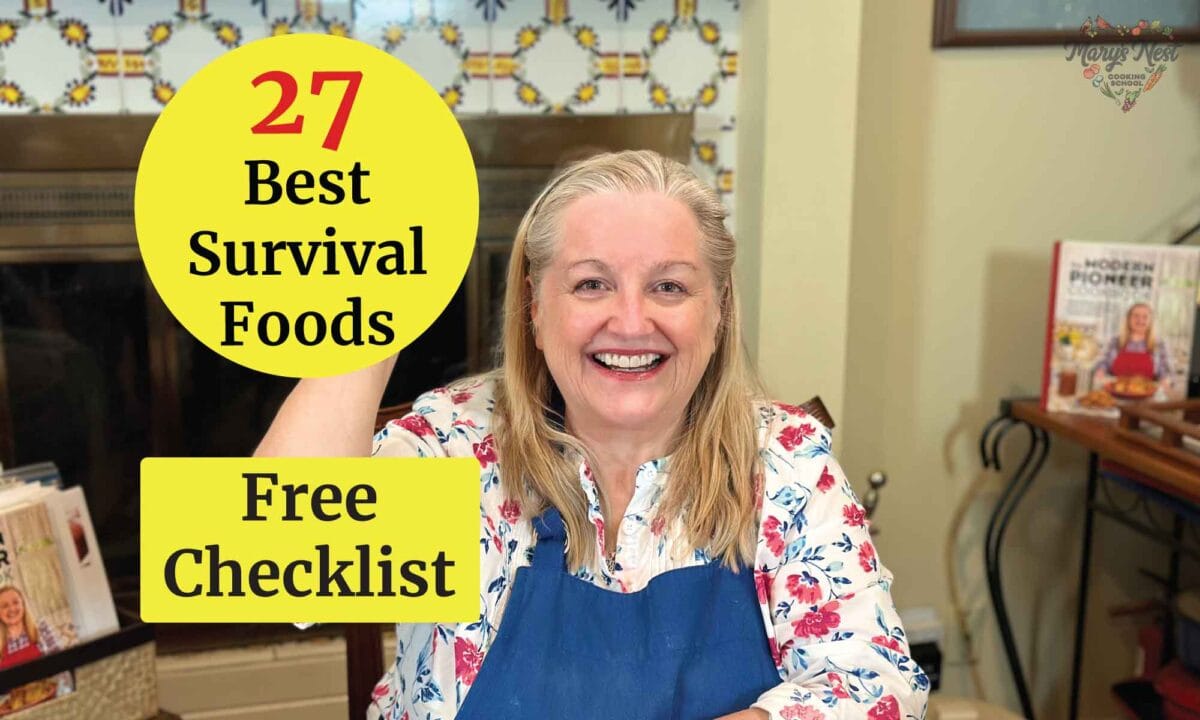
USDA Approved Foods
I’m sure you’ve heard stories about honey discovered in Egyptian Tombs that still looks like it could be used in our recipes today. Instead of looking to ancient hieroglyphs as a guide to our forever foods, we can consult a modern-day source from the United States Department of Agriculture (USDA).
The USDA lists foods that will last indefinitely, including properly stored foods in cans, bottles, and jars. Will these foods degrade in quality and nutrition over time? Yes, but they will likely never go bad, and they are exactly the kind of foods you want in your Survival Pantry. (Note: Always check any food after you open the packaging, whether you obtained it yesterday or many years ago.)
Learn more about forever foods with these USDA references:
Healing Pantry
The Healing Pantry is part of your Extended Pantry where you store the ingredients for making your natural or home remedies. As I describe in my 10 Essential Prepper Pantry Items to Stock Up On Now video, you may not always be able to immediately get the supplies you need to create your home remedies, so you’ll want to find a place to stock them in the Healing Pantry in your home.

For example, beeswax is an essential ingredient in creating salves, but it’s unlikely that you’ll be able to find it at your local grocery store, whether when daily life is routine or when there’s a disruption to our supply chain. If you make sure beeswax is in your Healing Pantry, you’ll be prepared to help take care of minor injuries that you or your family may encounter during calm times or during a natural disaster or other calamity.
Here are recipes for a few natural remedies you can make at home. Note that I call many of them master recipes since you can follow the steps in the recipe to make the remedy, but you can customize the ingredients that you use.
- Master Recipe for Medicinal Herb Tea
- Medicinal Herbal Oils and Herbal Salves
- Medicinal Herbal Tinctures Using Any Herb
- Medicinal Herbal Syrups Using Any Herb
- Master Recipe for How to Make a Medicinal Herbal Soup
- Medicinal Herbal Poultice
I enjoy studying herbs and their medicinal properties and reading books by Rosemary Gladstart, such as Rosemary Gladstar’s Medicinal Herbs: A Beginner’s Guide. This outstanding book will help you learn about some of the best herbs to grow, how to dry them, and how to make immune-boosting foods and natural remedies with herbs.
A Word of Caution as to Medicinal Herbs
Although we may think of herbs as just ingredients that we add to our pasta sauce, many herbs have potent medicinal properties and have been used as medicine for centuries. With this in mind, you need to approach herbs with knowledge and caution.
If you are pregnant, nursing, taking medication (over the counter or prescription), having allergies, or thinking of using medicinal herbs with children, make sure you first talk to your doctor, pediatrician, or other health care professional. You want to ensure that the herbs you plan to use will not adversely affect you or your children. I can’t stress this enough! Herbs are medicine. Never be casual or negligent in their use.
Where Should I Locate the Four Corners Pantry in My Home?
As you can see, a Four Corners Pantry includes more than just your kitchen pantry. Including the Extended Pantry’s subpantries, you can have seven to eight pantries in your home. So where do you have room?
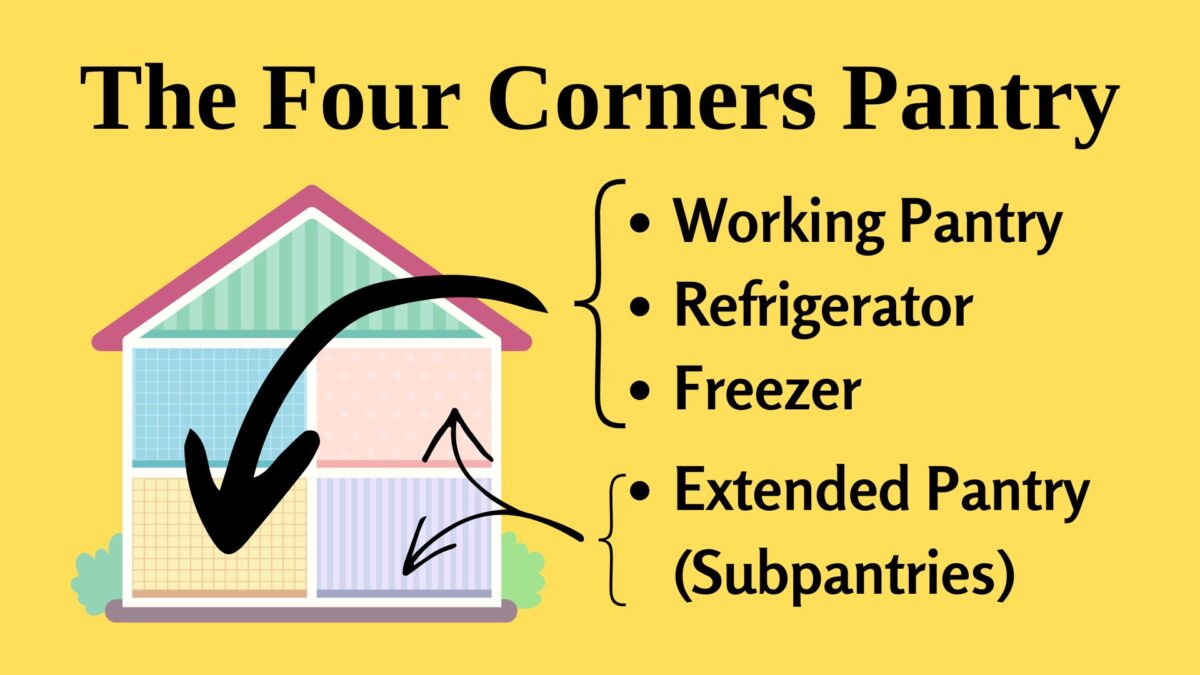
Fortunately, you don’t have to store your pantries all in one place. Your kitchen will probably have your Working Pantry, Refrigerator, and Freezer, but you can place Extended Pantries all around your house, wherever conditions are right to store your items. (Typically, cool, dry, and dark places are best to store items for the long term.)
Once you locate the ideal spots for your Four Corners Pantry and subpantries and stock them with the items you and your family need for the good and not-so-good times, you’ll be prepping like a pro!
Filling Your Four Corners Pantry with Traditional Foods
If you’re looking for a printed book full of my traditional foods recipes that shows you how to create a traditional foods kitchen, be sure to order your copy of my new bestselling book, The Modern Pioneer Cookbook.
And if you are teaching children in grades K through 12 how to make traditional foods, be sure to download my FREE Modern Pioneer Cookbook Curriculum to use in conjunction with my cookbook.
FREE CHECKLISTS You Need Now!
As you learn how to Prep Like a Pro when stocking your Four Corners Pantry, be sure to download all the checklists that I have prepared for you. You can keep them on your computer or phone, but I highly recommend printing them out and putting them in your Kitchen Journal so that you always have a hard copy!
How to Make Meal Prep Fast with the Meal-in-a-Bag System
Make meal prep fast and easy with these seven free recipes you can download and print out to create your own Meals in Bags.
The FREE Modern Pioneer Cookbook Curriculum – Teach Traditional Cooking Skills to Grades K-12
This cookbook curriculum gives students a love of traditional foods and kitchen skills that will last them a lifetime.
How To Build Your Great Depression Pantry
Download my free Great Depression Pantry Shopping Guide to identify the Depression Era Foods you need to stock to weather difficult times.
Download Your Free 36-Page Pantry List
For an extensive list of the traditional foods you can make and purchase to stock your pantry, be sure to download my free 36-page Traditional Foods Pantry List. This comprehensive eBook is full of links to recipe videos, helpful articles, and more!
Survival Garden Seeds
Did you know that you can also store seeds in your Survival Pantry? In my research into the best vegetable seeds, I discovered Survival Garden Seeds and their extensive collection of heirloom seeds. If you’re looking for high-quality, open-pollinated, non-GMO, and non-hybrid garden seeds, be sure to use my special MARYSNEST discount code to be able to get 10% off any of the following products:
- Home Garden Collection (30 Pack)
- Homesteader Collection (50 Pack)
- Farmers Seed Vault Collection (100 Pack)
- New: Ultimate Medicinal Herb Collection (36 Variety Pack)
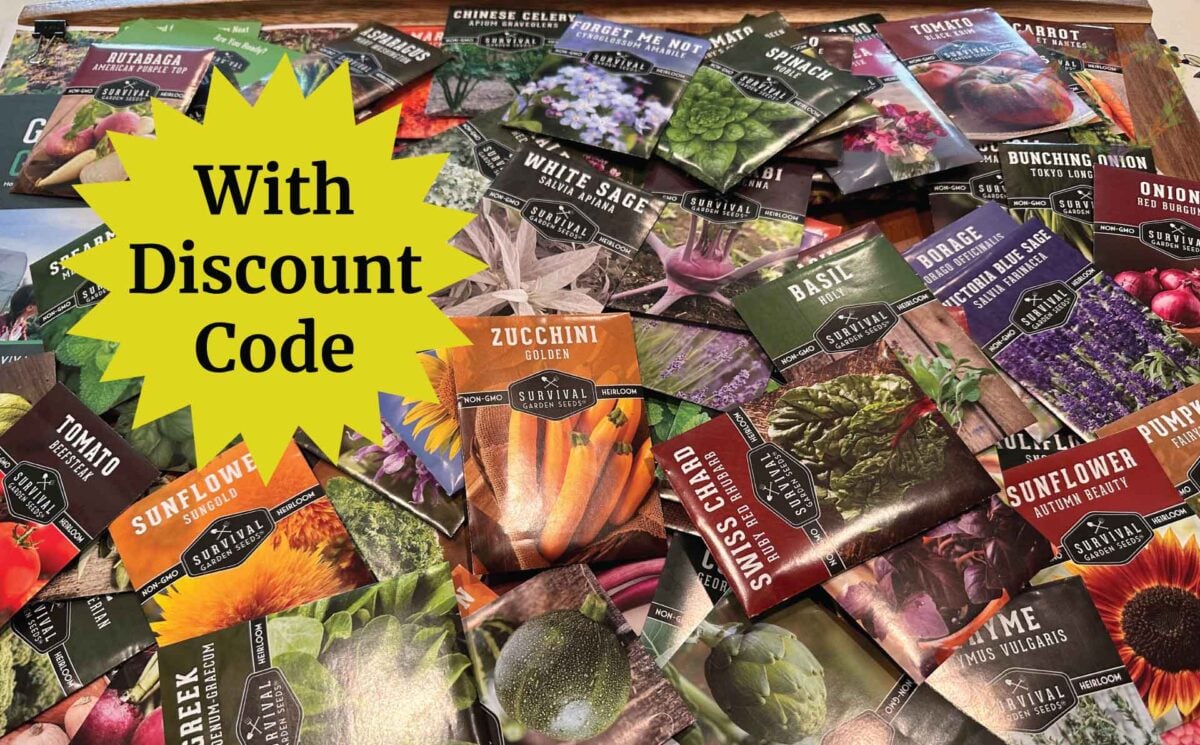
Join the Traditional Foods Kitchen Academy
Are you looking for more traditional foods videos? If so, I invite you to join the Traditional Foods Kitchen Academy. Members of this optional paid YouTube community get access to exclusive videos and other members-only perks. Plus, your YouTube comments include a special members-only badge.
Kitchen Academy Videos
The Only Traditional Recipes You’ll Ever Need!
Focus on traditional recipes with real food. Don’t chase trends.
Let’s Talk Akkermansia: A Tiny Helper for Big Gut Health
Discover how Akkermansia muciniphila supports gut and immune health—and how traditional foods help this mighty microbe thrive.
How to Eat a Mediterranean Diet with a Keto Twist
Explore a Mediterranean-Keto twist with a full sample menu focused on healthy fats, quality proteins, and low-carb veggies.
Stay in Touch with Mary’s Nest
- Subscribe to My YouTube Channel for Traditional Foods Videos (Free) - When you subscribe, be sure to click on the notification bell that will let you know each time I upload a new video.
- Subscribe to Mary’s Traditional Foods Newsletter (Free) - Get a free 36-page eBook for signing up: How to Stock Your Essential Traditional Foods Four-Corners Pantry.
- Join the Traditional Foods Kitchen Academy - For more detailed videos and exclusive members-only perks, join my YouTube membership community.
- Order The Modern Pioneer Cookbook - Get a hardcover book of Mary's nourishing recipes from a Traditional Foods Kitchen. This bestselling cookbook is published by Penguin Random House with their DK imprint.
- Preorder The Modern Pioneer Pantry - Be one of the first to get Mary's hardcover book about preserving food and making delicious meals from your Four Corners Pantry. Mary's second cookbook is also published by Penguin Random House.
I look forward to having you join me in my Texas Hill Country Kitchen!
Shop for items used in this blog post or video
Favorite Kitchen Supplies
- Favorite Aprons
- Spice Grinder
- Countertop Burner (On my kitchen island in many recipe videos.)
- Handheld Vacuum Sealing System
- Vacuum Lids
- Whisk
- Silica Gel Packets (Helps keep moisture from building up in your mix)
- Cast Iron Dutch Oven
- 8-Quart Slow-Cooker
- Fat Separator (Clever kitchen device to help you decant bone broth)
- Flour Sack Towels
- pH Strips (Helps you check on the acidity of your vinegar)
Amazon Shop and Shopping Guide
- Visit Mary’s Nest Amazon Shop
- Visit my Shopping Guide page
Get up to 15% off for stocking your Traditional Foods Pantry and equipping your Modern Pioneer Kitchen, including discounts from US Wellness Meats, Farmhouse Teas, Lehman's, Masontops, Cultures for Health, Survival Garden Seeds, Redmond Real Salt, Plan to Eat, and More!
Recommended Reading
- The Modern Pioneer Cookbook
- Nourishing Traditions
- Rosemary Gladstar’s Medicinal Herbs: A Beginner’s Guide
- The Nourishing Asian Kitchen
Disclaimer:I am not a medical doctor, a medical professional, a dietician, or a nutritionist. All content found on the MarysNest.com website, including text, images, videos, eBooks or eGuides, social media, or other formats, were created solely for informational purposes only. The content is not intended to be a substitute for professional medical advice, diagnosis, or treatment. Always seek the advice of your physician or other qualified healthcare provider with any questions you may have regarding a medical condition or proper nutritional advice. Never disregard professional medical advice or delay in seeking it because of something you have watched in a video or read on this website. Use caution when following the recipe in this video. The creator and publisher of this video and website will not be held responsible for any adverse effects that may arise from the use of this recipe and method or any other recipe and method on this website or corresponding video channel.
